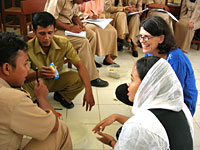Catastrophe, Education, and Hope
September 10, 2008 - Professional Development in Aceh After the Tsunami
"Before the tsunami, there were 17 classes with 40 children in each class," explains Kathy Schultz, "and afterwards, eight classes with about 20 children."
Schultz, an associate professor at GSE and Director of Teacher Education, was Penn's person-on-the-scene for its response to the 2004 tsunami that devastated much of coastal South Asia. Initiated by Penn President Amy Gutmann shortly after the disaster struck, GSE's effort focused on long-term recovery by working with locals to improve teacher education and professional development in the region.
 In July 2005, Penn GSE — partnering with the International Rescue Committee with generous funding from UK-based Pearson plc — sent a team of six experienced educators to Banda Aceh, Indonesia, to lead a two-week mentoring session for 100 master teachers. The idea was to revive a system of teacher training in Indonesia in which the master teachers would return to their districts to lead the professional development of local educators — in this case, thousands of teachers hired in the province to replace those lost in the tsunami.
In July 2005, Penn GSE — partnering with the International Rescue Committee with generous funding from UK-based Pearson plc — sent a team of six experienced educators to Banda Aceh, Indonesia, to lead a two-week mentoring session for 100 master teachers. The idea was to revive a system of teacher training in Indonesia in which the master teachers would return to their districts to lead the professional development of local educators — in this case, thousands of teachers hired in the province to replace those lost in the tsunami.
At the invitation of the Indonesian Ministry of Education and Syiah Kuala University, the Penn team taught four classes — literacy, science, mathematics, and pedagogy — to teachers from each of the 21 districts of the province.
The Penn team members, all firm believers in culturally situated pedagogy that pays particular attention to student voices and engagement, found themselves working with people whose only experience had been in traditional, formal classrooms — the kind where teachers lecture and students take notes. "Out of the devastation," Schultz explains, "arose an opportunity to introduce child-centered teaching methods to teachers whose prior education consisted solely of didactic teaching based on a national curriculum.
"We introduced them to new methods of teaching by teaching them to write, to ask questions about the moon, to think about fractions and geometry through using and playing games with materials.... We wanted to demonstrate to them the enormous talent and knowledge they each held and the interests, passions, and knowledge their children bring to school as a basis for teaching."
In three subsequent visits, Schultz and her colleagues turned their energies to sustaining the growth of this model of teaching. They worked to spur a self-sustaining professional development movement in the region — to provide teachers with the tools and the ability to share and improve their knowledge of teaching, children, and curriculum.
Even as the IRC and other international aid organizations leave the region, Schultz hopes to continue to visit and work with teachers in Aceh. Optimistic that Penn's involvement in the recovery efforts has made a positive impact, she says, "Ultimately we want to make ourselves obsolete. We hope the teachers will adapt and use the ideas we have introduced to improve their pedagogical practices."
"One of our greatest challenges has been teaching across the cultural and language barriers that often seemed to obscure meaning and leave us more questions than answers about the efficacy of our work," she adds.
"Yet in small moments, and often through nods and smiles, participants conveyed gratitude and understanding, suggesting that the ideas might travel to places we couldn't imagine and have an impact we could not predict."
